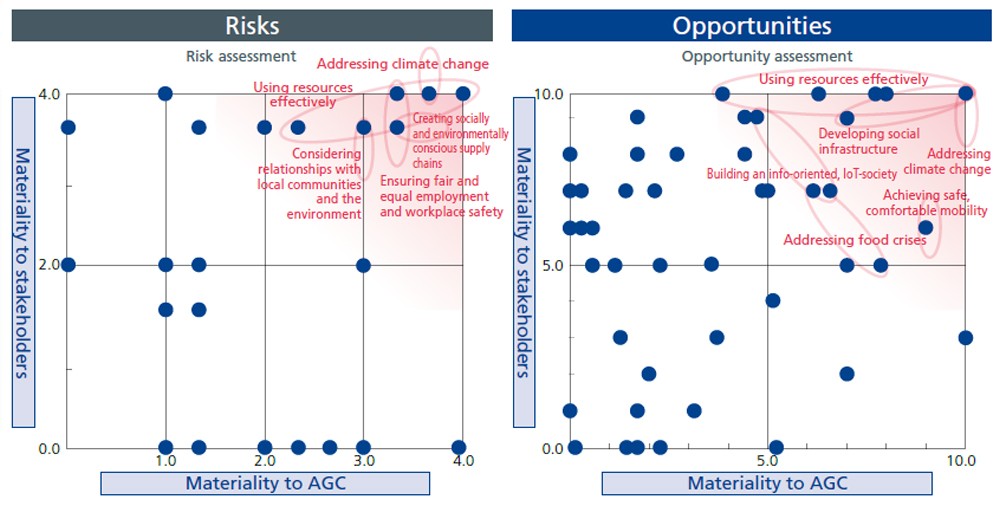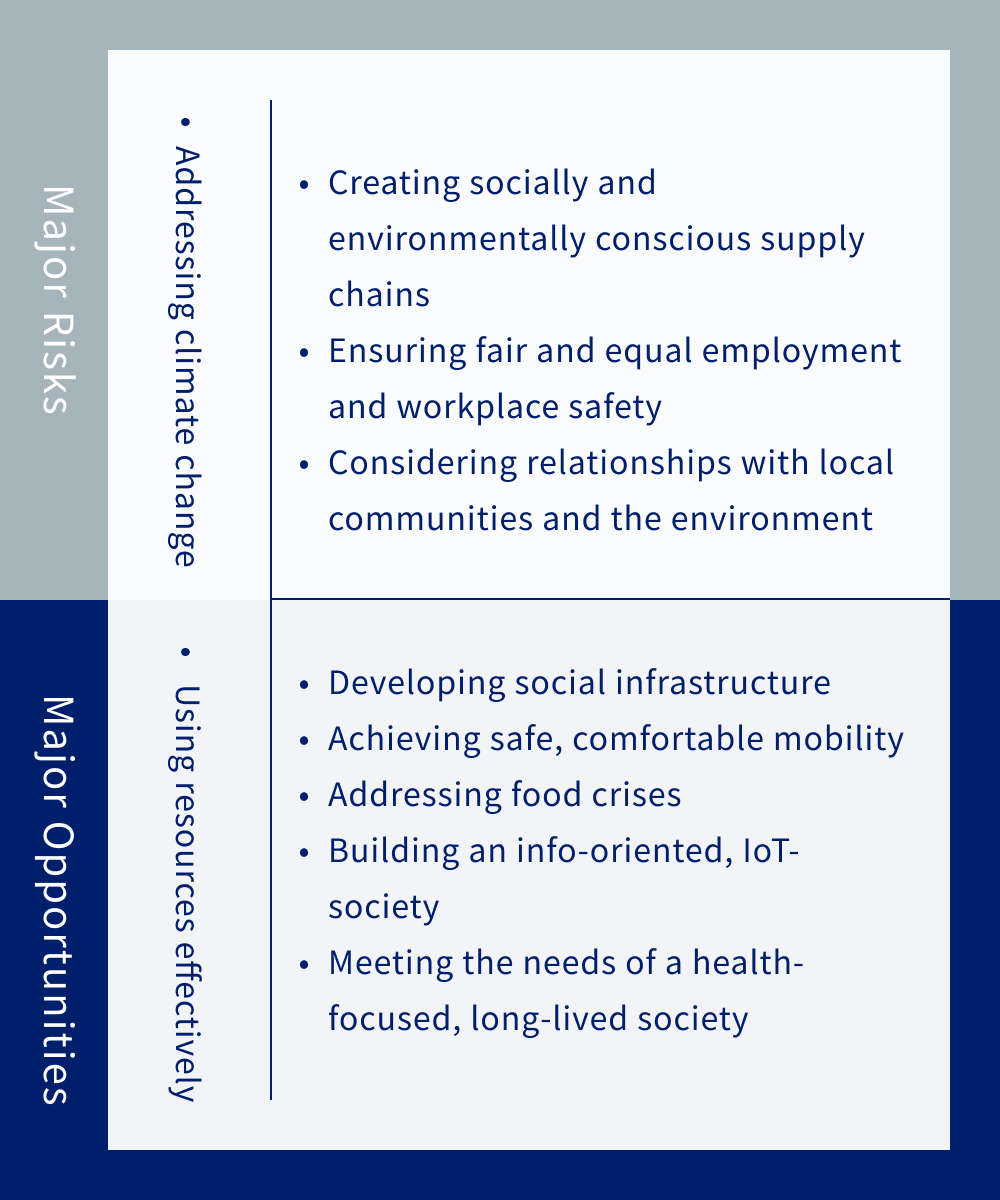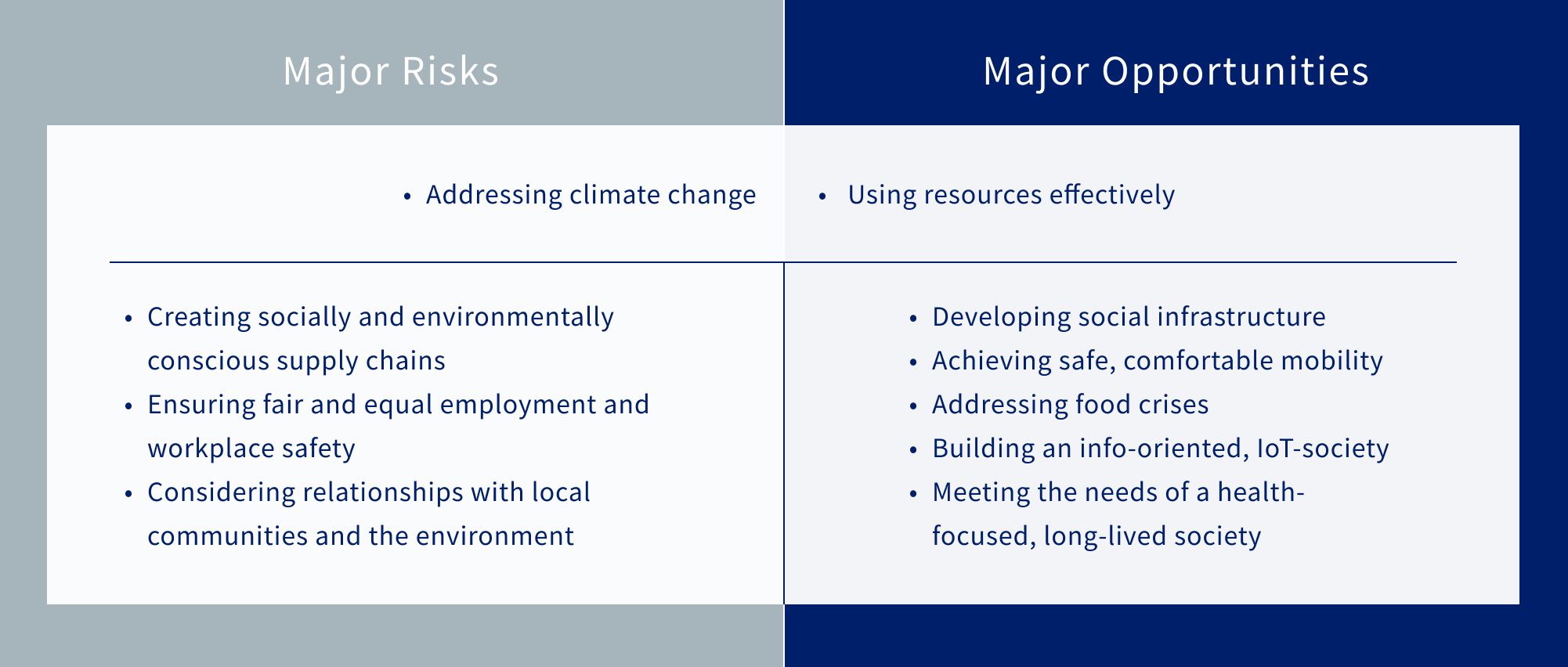Long-Term Social Issues (Materiality)
-
- Major Opportunities
- Major Risks
Since the Paris Agreement was reached in 2015, a shift toward decarbonization has been gathering momentum. Stricter energy-related policies and statutory regulations are expected. Also, social demand is growing for companies to achieve net-zero greenhouse gas emissions.
-
- Major Opportunities
- Major Risks
There are concerns that stricter regulations on the use of depletable resources, such as rare earths, and higher demand for water resources accompanying further urbanization could seriously impact the production activities of companies. In addition, as the recycling-based economy accelerates, society increasingly expects companies to reduce waste and promote recycling.
-
- Major Opportunities
While the economic growth of emerging countries necessitates the development of such social infrastructure as housing, roads, railroads, and public services, developed countries must deal with the aging of their social infrastructure. Moreover, there is a growing need to develop resilient infrastructure that can withstand the intensified disasters being caused by climate change.
-
- Major Opportunities
The spread of automobiles in emerging countries is causing concern over rising traffic accident deaths. Meanwhile, addressing the mobility needs of the elderly, those living in less-populated areas, and other vulnerable groups in society is becoming increasingly important. Further, as autonomous driving becomes more widespread, expectations are increasing with respect to the establishment of safety technologies, such as sensors and cameras, and the enhancement of in-car entertainment.
-
- Major Opportunities
With the spread of information and communication technologies in emerging countries, reliable, inexpensive access to information needs to be provided. In developed countries, the early dissemination of next-generation high-speed communication technologies, such as 5G, promises to improve the quality of remote medical care and information transmission.
-
- Major Opportunities
Given that the number of young people losing their lives due to non-communicable diseases remains high worldwide, there is a need to reduce such deaths by providing stable supplies of pharmaceuticals for prevention and treatment. In addition, a trend toward increased division and specialization in the pharmaceutical industry, which is aimed at improving the productivity of the industry as a whole and diversifying its risks, is becoming more pronounced.
-
- Major Opportunities
The problems of hunger and malnutrition in the world’s poorest regions have yet to be resolved, and there are concerns that the situation will worsen due to disasters and droughts caused by the climate change of recent years. Also, to cope with a growing world population, food productivity must improve.
-
- Major Risks
As supply chains become more globalized and complex, the risk of issues arising in relation to illegal employment, such as forced labor and child labor, at suppliers and subcontractors is increasing. Further, tighter environmental regulations are leading to concern over potential regulatory violations at operating bases.
-
- Major Risks
There is a growing need for compliance in employment and respect for workers’ rights as well as for safety measures at manufacturing sites due to the increasing number of unskilled and elderly workers.
-
- Major Risks
Due to population growth and urbanization in various parts of the world, interest in expanding living areas and maintaining biodiversity in surrounding areas is growing. Also, in emerging countries there is an increasing focus on improving quality of life as living standards improve. Efforts to build good relationships with local residents and governments in the vicinity of operating bases are also becoming more important.
Process for Identifying Long-Term Social Issues (Material Issues)
- 01
SDGs mapping
To enable analysis of our long-term social issues, we reconfirmed our current progress toward the realization of sustainability by using the 169 targets of the SDGs as the basis for an analysis of the types of social issues addressed by our existing products.
1. Focus on existing mainstay products in each business field
2. Calculate the “business impact score” for each product based on its sales and growth potential
3. Link each product to the SDG targets to which it can contribute
4. Describe the type of social value that the AGC Group is creating in relation to each SDG by taking into account the contributions of all products linked to a given targe
5. Add up the total business impact score of all products linked to each type of social value
6. Correct the business impact score for each type of social value based on the degree of contribution to addressing social issue
7. Set the corrected results as the social impact score and identified the top 15 types of notable social value
The above procedure identified fields where existing products can help address current social issues
-
Energy saving, creation, and storage and climate change mitigation
-
Construction of smart cities
-
Provision of reliable, safe water resources
-
Realization of safe, comfortable mobility
-
Health improvement and realization of longer life spans
- 02
Analyzing social issues and trends
In light of its current contributions to the resolution of social issues, important opportunities and risks for the Group going forward were identified through analysis of future trends in social issues. (The analysis results were also used as basic information in preparing Vision 2030.)
1. Compiled a list of social issues
・ 169 targets of the SDGs
・ Sustainability megatrends (circular economy, etc.)
・ Based on the Global Risks Report (World Economic Forum), compiled a list of items representing opportunities and risks for the AGC Group (79 items in total)
2. Assessment of major risks and major opportunities
We evaluated “major risks” and “major opportunities” for stakeholders and the AGC Group from the perspective of social issues.

- 03
Identifying major opportunities and major risks
Based on the results of analyzing trends in social issues and in light of expert opinions, we identified major opportunities and major risks associated with simultaneously achieving sustainable development of the planet society, and sustainable growth as a corporate group. These opportunities and risks are discussed and determined by the Sustainability Committee and the Board of Directors and were then used as the foundation for setting sustainability targets.


- 04
Decision made through discussions by the Board of Directors
-
These opportunities and risks were discussed and determined by the Sustainability Committee and the Board of Directors and were then used as the foundation for setting sustainability targets.
- 05
Reflecting in management strategies
Please refer to the AGC Sustainability Data Book for specific details on each key risk and opportunity, along with examples of our initiatives.











